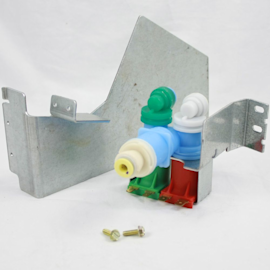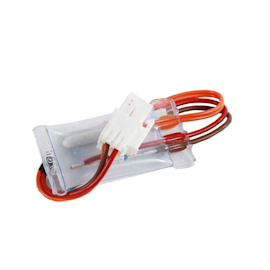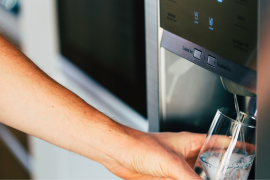How to use your refrigerator efficiently


Taking steps to save energy when using your fridge will collectively help the environment and can save you a bit money on your electric bills. Two of the most significant benefits of using your refrigerator efficiently are that the fridge will last longer and foods will continuously be cooled to a safe temperature so they last longer.
Follow these expert tips to ensure that your fridge stays in top shape and works at peak efficiency.
Check the refrigerator settings
The refrigerator temperature setting should be at 37 degrees F for the fresh food section to prevent dairy products from spoiling and bacteria from contaminating food. Set the freezer temperature at 0 degrees F to preserve frozen foods and allow the ice maker to cycle efficiently.
For energy efficiency, minimize the use of the Rapid Ice or Fast Ice setting on your fridge. This setting reduces freezer temperature to -5 degrees F in many models to speed up ice production. Some models also turn on a fan in the ice compartment to help speed up ice production. Using the accelerate ice setting in some refrigerators can cause items at the back of refrigerator section shelves to freeze. Freezing some foods in the fridge section can cause spoilage.
Some refrigerator models have a Fast Freeze or Quick Freeze feature that makes the freezer section colder (-5 degrees F) so fresh food quality is preserved by freezing food at a faster rate. As with the accelerated ice feature, you should minimize your use of the Fast Freeze feature to save energy and help your fridge work efficiently. Items on the back of fridge section shelves can freeze and spoil when using the Fast Freeze setting on some refrigerator models.
Some refrigerators have dial or knob settings instead of digital temperature settings. To set the temperature properly using a dial or knob, start by choosing the middle setting for the freezer and fridge. Using the middle settings typically cause the fridge section to cool to 37 degrees F and the freezer section to cool to 0 degrees F. You can check temperature inside each section using a thermometer and adjust the dial or knob settings as needed to achieve these optimum temperatures inside your fridge and freezer. After making adjustments, give the fridge about 24 hours to equalize temperatures in each section before measuring temperatures and making further adjustments.
Keep your fridge organized
Overfilling your fridge or freezer can cause air flow problems. Know where air supply and return vents are located in the fridge and freezer. The owner’s manual will show the location of these vents for most refrigerator models. Don’t block air flow through the refrigerator section by overcrowding shelves or placing large items directly in front of air vents. Follow the same strategy in the freezer section to keep air paths clear.
Keep your fridge and freezer sections organized to minimize the time that the doors are open. The refrigerator has to work harder to cool down the sections the longer that you have the doors open. Let all family members know how important it is to get what you need and shut the refrigerator and freezer door promptly to avoid wasting energy.
Let hot foods safely cool before placing them in the fridge or freezer
Placing hot items directly in the fridge raises the internal temperature and forces the refrigerator to work harder. Allow hot foods to cool down before placing them in the fridge or freezer.
Follow safe food handling guidelines when letting foods cool. According to the U.S. Department of Agriculture, “leaving food out too long at room temperature can cause bacteria to grow to dangerous levels that can cause illness.” Never leave food out of the refrigerator over 2 hours. If the temperature is above 90 °F, food should not be left out more than 1 hour. Put leftover cooked foods in shallow containers for quick cooling and store them in the fridge or freezer within 2 hours.
Use the crisper drawers wisely
The crisper drawers in most refrigerators have a slide opening on the handle that controls humidity inside the drawer. Slide the humidity control fully open (low humidity setting) to store fruits and vegetables with skins such as tomatoes, mushrooms, apples and pears. Close the humidity control slide to maintain high humidity in the crisper drawer for leafy items such as lettuce, spinach, cabbage and kale.
Using the humidity controls on crisper drawers will help fruits and vegetables last longer in your refrigerator – saving you money on your grocery bill.
Maintain proper ventilation space around your refrigerator
Follow the installation instructions to make sure that you keep proper ventilation clearance on all sides of your fridge. You’ll typically need to leave a gap on all sides of your fridge to allow air flow through the condenser coils for heat dissipation. Blocking air flow through the condenser coils will cause the compressor to work harder to cool the freezer and refrigerator sections.
Also, avoid placing your refrigerator near heat sources such as ovens, stoves, or direct sunlight. Ventilation air around the fridge needs to be at normal room temperature. High ambient temperatures can make the fridge work harder to maintain cool temperatures.
Perform regular fridge maintenance
Keep your refrigerator clean and perform regular maintenance tasks so that your refrigerator operates efficiently.
Clean the interior
Spills can build up inside your refrigerator. At least once a year, you’ll need to pull everything out and wipe down the shelves and walls using baking soda and water to remove deposits and stains. You may need to use a nonabrasive scrubber to remove stubborn spills and stains. Start at the top of the interior and work your way down to the bottom.
Cleaning the interior regularly will help prevent bacteria in the fridge. Also, drawers will slide in and out easier when they’re clean.
Clean the exterior
Follow the directions in your owner’s manual to clean the exterior of your refrigerator. You can use wash cloth moistened with mild soapy water to clean the exterior on most fridges. Use stainless steel cleaner to clean the cabinet if you have a stainless fridge.
If your fridge has an ice and water dispenser, pull out the drip tray and clean the dispenser housing thoroughly to prevent mold and mildew from building up in that area.
Don’t forget to clean dust off the toe grill vent and the ventilation holes on the back of the fridge. This step will help keep air flowing through the condenser so your refrigerator will cool efficiently.
Replace the water filter every 6 months
To ensure your water filter can trap all the impurities and contaminants it’s been proven to remove, replace your refrigerator water filter every 6 months.
Failing to replace the water filter regularly can expose you and your family to unsafe and poor tasting drinking water and ice. A water filter that’s past its prime also can cause diminished water flow through the water dispenser, leading to smaller ice cubes because water doesn’t fully fill the ice maker tray.
Clean the condenser coils
The refrigerator’s cooling system won’t work efficiently if condenser coils are dirty. That translates into higher energy bills and more wear and tear on the compressor because it has to run longer to cool the refrigerator.
Follow the tips in this video to clean the condenser coils on your fridge.
Have your refrigerator professionally maintained by a Sears Technician
Keeping your refrigerator in top shape by having it professionally maintained by Sears helps it last longer and work more efficiently — saving you money. During Sears Clean & Maintain Service, the technician will:
Check and adjust temperature controls and air dampers. Maintaining the proper temperature inside the refrigerator and freezer compartments helps minimize food spoilage. The technician will measure temperatures inside the refrigerator and freezer compartments and adjust the settings if necessary. The technician also will let you know if the temperature control system isn’t working properly and needs repair.
Test the automatic defrost system. If the defrost system isn’t working properly, frost buildup on evaporator fins will block airflow and the refrigerator and freezer won’t cool properly. The technician makes sure that this system works properly to help keep your refrigerator from experiencing cooling problems.
Check and clean the defrost drain system. The water that drips off the evaporator fins during the defrost process drains through a tube and into a pan next to the compressor. If the drain tube gets clogged, water will drip inside the refrigerator or freezer compartment. To prevent that from happening, the drain tube will be checked and clogs cleared. The Sears technician also will check the drain pan and clean if needed. It’s possible for pests or rodents to get into the drain pan and cause a stink, so this check helps avoid surprise odors, not to mention saving you from having to remove a dead rodent.
Clean the condenser coils (if you haven’t already completed this step yourself).
Check, clean and adjust door seals. Loose or dirty door seals can allow warm, moist air to leak into the refrigerator and/or freezer section, causing dairy products to spoil quickly in the fridge or frost to form on food in the freezer. The compressor has to run longer to cool the refrigerator and freezer when air leaks through door seals, meaning – you guessed it – higher energy bills. The technician will check, clean and adjust seals as necessary.
Level the cabinet. Refrigerator doors won’t close all the way if the cabinet isn’t properly leveled, letting warm air into the fridge and causing cooling problems. A Sears technician will make sure the cabinet is level during the appliance check.
Check the water filter date and advise you on filter replacement if necessary.
Check the ice maker and dispenser system. If your refrigerator has an ice maker and dispenser system, the technician will check for proper ice operation and water flow. Because an ice cube can get stuck in the ice dispenser door (which would cause cooling problems in the freezer), the technician will check the ice chute and ice dispenser door for stuck cubes. Additionally, the tech will test ice maker operation and the ice level detection device for the ice storage bin.
In summary, keeping your fridge in top shape will help it run efficiently and last longer. You’ll reduce energy consumption while keeping your food fresh and safe when you use your fridge efficiently.
Repair guides for bottom-mount refrigerators

How to replace a door gasket in a French-door refrigerator
The door gasket, often called a door seal, seals the gap around the door to keep the cold air in and the warm air out. R…

How to replace a refrigerator water valve
Replace the water valve that feeds water to the ice maker and water dispenser if it no longer controls the flow of water…

How to replace a refrigerator defrost control assembly
Follow these steps to replace the defrost control assembly if your Kenmore or LG French door refrigerator displays an er…
Articles and videos for bottom-mount refrigerators

No matter what style Maytag refrigerator you have, we can walk you through replacing the water filter.…

Learn about all the convenient features on our Sears PartsDirect website that make your parts purchases easier.…

Get answers to frequently asked questions about Sears and Sears PartsDirect.…